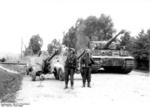76 mm Divisional Gun M1942 (ZiS-3) Field Gun
| Country of Origin | Russia |
| Type | Field Gun |
| Caliber | 76.200 mm |
| Weight | 1116.000 kg |
| Ammunition Weight | 6.20 kg |
| Rate of Fire | 25 rounds/min |
| Range | 13.290 km |
| Muzzle Velocity | 680 m/s |
Contributor: C. Peter Chen
ww2dbaseWhat would later come to be known as the 76-millimeter Divisional Gun M1942 (ZiS-3) weapons were designed by the No. 92 Artillery Factory "Zavod imeni Stalina" under chief engineer V. G. Grabin, who went ahead with this project starting in 1940 without government authorization. The first gun was built in 1941 in secret. When Germany invaded the Soviet Union later in the year, many of the previously-deployed 76-mm guns were destroyed or captured, and Soviet leadership called for factories to build replacement 76-mm guns. With the ZiS-3 design still in secret, the chiefs of No. 92 Artillery Factory nevertheless decided to produce them. When the first batch was ready to be delivered, the unauthorized design was discovered, and initially Soviet Army representatives rejected delivery; it was only the demands of war and Grabin's personal guarantee that saw the acceptance of these new guns. The new ZiS-3 field guns soon proved to be better than the pre-war 76-mm gun designs and, with Joseph Stalin's full support, became the standard divisional field guns after a series of tests in Feb 1942. Each of the ZiS-3 guns required a crew of seven to operate, and a typical battery after 1942 consisted of four ZiS-3 guns. While they were effective as anti-tank guns against German medium tanks, their greatest capability was perhaps in the design, which simplified the production, allowing a lower-skilled workforce to achieve a higher quantities of guns. When the European War ended, more than 103,000 guns were built.During the war, Finnish forces captured 12 ZiS-3 guns; they were pressed into service with the designation 76 K 42.
Although 76-millimeter Divisional Gun M1942 (ZiS-3) weapons were replaced by D-44 guns in the Soviet forces shortly after WW2, they remained in service in forces friendly with the Soviet Union, some until this date.
Source: Wikipedia ww2dbase
Last Major Revision: Feb 2012
76 mm Divisional Gun M1942 (ZiS-3) Field Gun Mapa Interativo
Photographs
 |  |  |  |
Você gostou deste artigo ou achou este artigo útil? Se sim, considere nos apoiar no Patreon. Qualquer valor já vai ajudar! Obrigado. Por favor, ajude-nos a divulgar o site: Fique atualizado com WW2DB: |
Visitor Submitted Comments
All visitor submitted comments are opinions of those making the submissions and do not reflect views of WW2DB.

- » Wreck of Teruzuki Found (27 jul 2025)
- » USS Orlean's Bow Found (22 jul 2025)
- » The Emperor of Japan Planned to Honor WW2-era Japanese POWs in Mongolia (4 jul 2025)
- » US State Lawmaker John Winter Caught Using Racial Slur "Jap" and Apologized (11 jun 2025)
- » US Government Plans to Purge WW2 Information (17 mar 2025)
- » Ver todas as notícias
 |
- » 1,182 biografias
- » 337 eventos
- » 45,119 entradas na linha do tempo
- » 1,248 navios
- » 350 modelos de aeronaves
- » 207 modelos de veículos
- » 376 modelos de armas
- » 123 documentos históricos
- » 261 instalações
- » 470 resenhas de livros
- » 28,411 fotos
- » 365 mapas
Chiang Kaishek, 31 Jul 1937
Por favor, considere nos apoiar no Patreon. Mesmo R$1 por mês já faz uma grande diferença. Obrigado!
Ou, por favor, nos apoie adquirindo alguns produtos do WW2DB na TeeSpring. Obrigado!
20 Mar 2020 08:06:52 AM
The Soviet 76.2mm ZiS-3 was nicknamed Ratch-boom (crash boom) by the Germans on account of its barely discernible interval between firing and impact